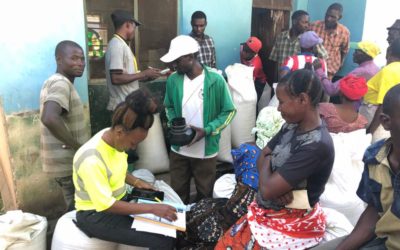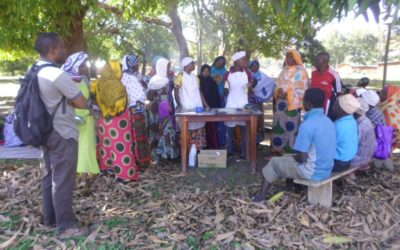Where are the young farmers?

The village of Rakhra in Punjab, India, is home to about 2,500 people and a great story. In the years following its independence, India had the critical task to develop its agriculture sector. Rakhra, with its saline soil, was an unlikely place to sprout prosperity.
However, Vice Chancellor of the Punjab Agricultural University, Dr. Amrik Singh Cheema, saw that building an agricultural infrastructure and training the farmers of the village could kick-start Rakhra’s agrarian economy once again. Young, entrepreneurial members of the village believed in his vision and worked under his leadership to not only till the soil, but also to involve themselves in government agencies, improve the infrastructure and progress toward social integration. And so the Young Farmers’ Association (YFA) came to be.
Today Rakhra, at the heart of a region called ‘India’s Granary’, is a centre for dissemination of scientific agricultural knowledge and technology. The YFA sprouted the Young Farmers’ Training Center (YFTC), an education and research facility, that eventually partnered with the FAO to deliver courses for the community. The region-specific knowledge gained from this facility has helped create and adopt varieties of wheat and rice that produce higher yields and are better resistant to diseases and other environmental factors.
The Indian Agricultural Research Institute (IARI) now works closely with the YFTC to demonstrate new crop varieties and provide improved seeds to farmers. Today, YFA has some 9,000 members across India and the world. They meet twice a year to discuss the latest findings in agricultural research, especially from the IARI and the Indian Council for Agricultural Research.
This proves the adage that young people can bring about lasting, positive change. Farming is unfortunately, however, not a field that attracts young professionals for a myriad of reasons: agriculture is a high-risk environment, with many uncontrollable forces, unpredictable profits, and high initial investments. Beside this, young people do not view farming, or rural culture for that matter, as a lifestyle to aspire to. This has to do, in part, with the lack of infrastructure in rural areas, such as access to a reliable internet connection.
It is important to take into consideration that today’s youth are part of a generation with access to a higher quality of education than previous generations. However, this has not produced the expected outcome.
“Various studies have noted how education as currently practised (particularly secondary education) contributes to a process of ‘deskilling’ of rural youth in which farming skills are neglected and farming itself downgraded as an occupation… those children who had gone to school found themselves both ill-prepared for the kinds of work available locally, and inadequately educated for other kinds of employment.”
– Ben White, Agriculture and the Generation Problem
Another problem faced by youngsters looking for farm work is finding land for cultivation. Government supported corporations are behind large-scale acquisitions for commercial agriculture that leaves little room for small-scale farming. These capital and energy intensive farms do little to help the local economy they imbed themselves in, despite being built on government and corporate promises of jobs and income. The World Bank’s report on industrial farming in rural lands finds that these farms are environmentally destructive, they disadvantage women, and ignore the proper legal procedures for land acquisition, thereby forcibly displacing large numbers of people.
Besides the lack of infrastructure in rural regions, young people also struggle with the gerontocracy that controls resources and establishes the law. There is a long period that young people have to wait before they can begin to farm independently, because, in most agrarian societies, older generations retain control over land for as long as possible (White, 2012). Agrarian societies are strongholds of patriarchal traditions, where harsh discipline is imposed and respect for older generations is expected. This reduces the agency of young people, especially women, in their economies.
I believe that smallholder farming must exist into the future. There are too many factors that favour small farms against large-scale farming, which are economically, ecologically, and sociologically too important to be overlooked. But the number of small farmers are dwindling in the face of corporate takeovers. The hostility of the countryside to young people is both a cause and symptom of this problem. This is unfortunate because agriculture is a field that is in dire need of young blood, and the innovation that comes with it.
To attract young people to the countryside again, for agricultural or non-agricultural ventures, governments must focus on rural regions when developing infrastructure. Modern day essentials like 4G services need to be readily available for youngsters to consider a future in the countryside.
Young people also need to be granted social mobility in their villages. They need to have the agency to achieve economic independence, to own land and to run businesses and innovations without fear of backlash from village elders. This also means empowering women to have equity in land ownership, education, business and financial assistance.
Rural finance is another neglected sphere when compared to its urban counterpart. Urban dwellers are likely to have four times the access to financial services as those living outside cities. The case is worse for women. Since farmers and agribusinesses are intrinsically rural and dispersed, banks find it challenging to penetrate this market. However, a recent report finds that developing digital finance infrastructure can alleviate some of the disparities.
For decades now, youngsters have seen migrating to urban centres as the natural path to progress. The pervading narrative of the world is also that economies have to move from being agriculture based to service based as nations achieve their “adulthood”. This thinking has been detrimental to our growth, especially in the poorer countries of the world, and led to some unsustainable practices. As I have often said before, we only grow when our farmers grow. It is time for us to shift focus to the countryside and nurture this growth by nurturing our young to ensure they have a future.
Continue Reading
The road ahead – recovering from the ongoing pandemic and the ramifications to come
The FAO is calling for solidarity in support of people around the world in the time of a global pandemic. In the agriculture sector, we are seeing how fragile our existing systems were and continue to be, with every link in the supply chain looking the worse for wear.
Digital finance – including smallholder farmers in the equation
Digital tools have the ability to strengthen agricultural transformation, specifically digital tools for finance.
The Smart Food of the Future
The ETG Farmers Foundation (EFF) contributed to a Smart Food initiative, carried out chiefly by the International Crop Research Institute for Semi-Arid Tropics (ICRISAT), in addition to nutrition workshops it held with farmers to promote pulses as food.




0 Comments